A song so beautiful it brings the world back into tune.
But’s a sad song.
It’s an old song.
And it is finally, finally here at Baltimore’s Hippodrome Theatre!
The train on that long road to hell has arrived, bringing you the epic, Tony Award-winning musical Hadestown. With music, book, & lyrics by Anaïs Mitchell, this stylistically mesmerizing and wondrously refreshing take on an ancient Greek myth will dazzle and amaze, charm and surprise you; it is a breathtaking delight that is both bittersweet and beautiful. Developed with and Directed by Rachel Chavkin, with Choreography by David Neumann, and a live-on-stage orchestra conducted by Eric Kang, you’ll want to ride the train to Hadestown again and again and again. No question.
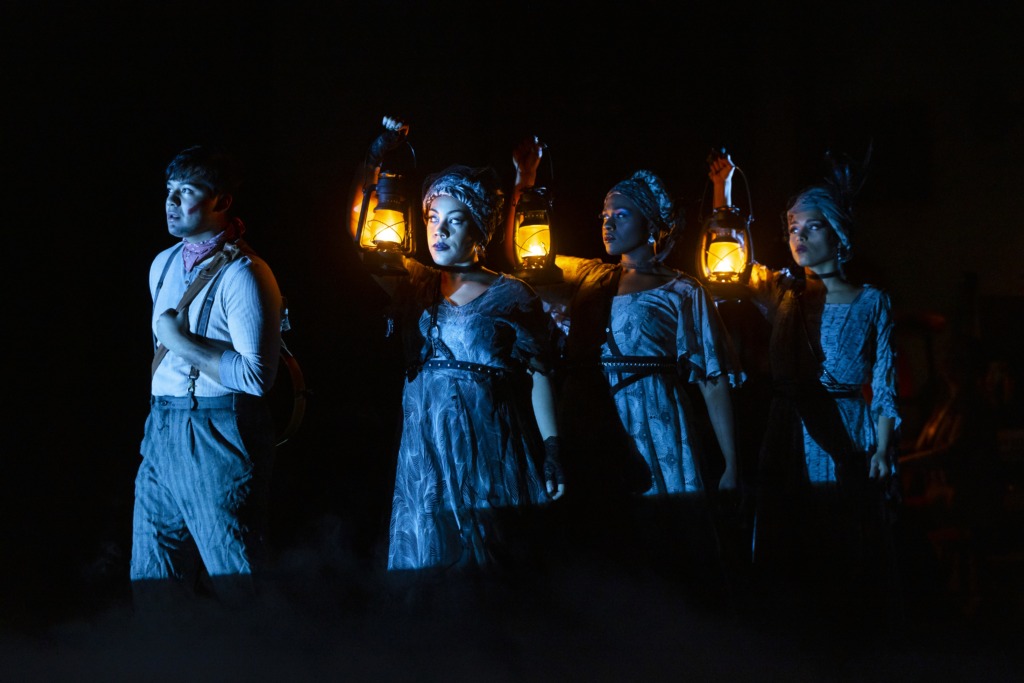
It’s a spiritual story; it’s a human story; it’s an allegory; it’s the truth. Rarely does a musical come along with so many components blended so flawlessly all into one in the way that Hadestown does, it’s easy to see how Anaïs Mitchell’s revitalizing masterpiece won so many Tonys. Whether you know the story of Orpheus and Eurydice or not, you’re in for a true treat; this ain’t your grandfolks’ Greek-Mythology. Mitchell’s work brings together a surprisingly magical blend of musical styles, narrative styles, and infuses the world of Hadestown with glimpses of reality, fantasy, sprinkles of political commentary, and a whole mess of emotions that makes it a phenomenal experience regardless of which emotion or character you walk away connecting with the most.
Running a musical labyrinth of everything from N’ Orleans jazz and soul to Tin Pan Alley, gospel, blues, and of course your more traditional Broadway-musical style numbers, Mitchell’s creation is effervescent, with the music practically leaping off the stage, and spinning its way straight to your ear. Adding an extra layer of impressive fascination to the production is the construct of setting the seven* piece orchestra live on stage like a framework, alluding to the fact that music frames our world no matter where we are in life. (Percussionist Eladio Rojas remains off-stage though is given great praise and due when the Persephone character takes to introducing and applauding the band at the top of the second act like a proper concert official might do.) Trombonist Emily Frederickson is even mobilized in a couple of the more upbeat, jazz-blasting numbers, sliding that trombone like she slides her feet, with a serious sense of rhythm and it becomes an impressive feat to behold. The seven-piece orchestra— conducted by Eric Kang on keys and featuring Natalie Spehar on cello, Clare Armenante on violin, Michiko Egger on guitar, Emily Frederickson on trombone, Calvin Jones on double bass, and Eladio Rojas on drums— is an integral part of the experience; many of these players feature brilliant and at times haunting solo moments that reverberate not only through the show’s narrative but into your musical experience, echoing around and around inside your mind as you ingest everything that’s happening on stage.
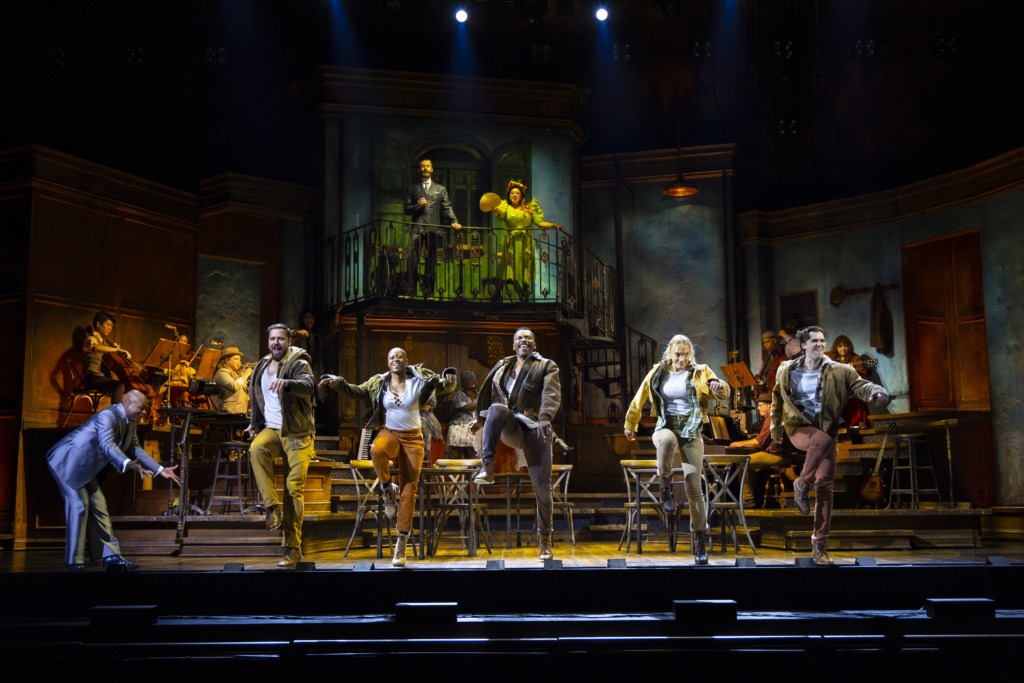
The stage itself is dressed with an impoverished, semi-industrial, hinting-at-the-French-Quarter-of-New-Orleans-maybe motif laid down by Scenic Designer Rachel Hauck. The set itself is both deceptively simplistic and fascinating, particularly when it comes time for the exploration of Hades’ underworld. While it may seem little more than the interior of a café, maybe even one somewhere in the French Quarter or right on Bourbon Street, Hauck’s clever construction evolves into so much more, serving as both backdrop and vessel for the show’s existence and its journey. When the walls split apart, expanding the space into the vast fathoms that are Hades’ underworld, it is an awe-inspiring moment; things aren’t always as simple as they seem, and Hauck’s set-in-motion reflects that resplendently. This is even more true when the penultimate moment of the story occurs, with the set slowly pulling itself back together.
Accentuating, assisting, and overall augmenting the deceptively delicious set is the illuminating work of Lighting Designer Bradley King. Light and darkness play tremendous roles in this production of Hadestown almost like they are secondary characters to those being embodied by living, breathing, human beings. It’s more than just playing with shadows or brightness, it’s the way King deploys light— both when and how— and in varying states of brightness and color all throughout the performance. The lights create atmosphere— with flushes of color that back-wash the walls in appropriate matches of mood, emotion, or personality (look at Persephone’s spring-time dress and watch the walls when she’s singing her sassy songs in that outfit.) The lights also create pathos, comforting and discomforting characters— particularly Orpheus— on his journey. And when Hades calls to power his command of the electric city King’s lights put the crown upon the king of the underworld. Everything from swinging mineshaft lanterns and ghostly glowing hand-lanterns all during “Doubt Comes In” to the burning, backlit glow of hellfire during “Why We Build the Wall”, and all the illuminating tricks of the trade featured in-between; King has masterfully constructed composite characters of light and shadow through his lighting design, creating a vibrant and equally harrowing visual experience for this production.
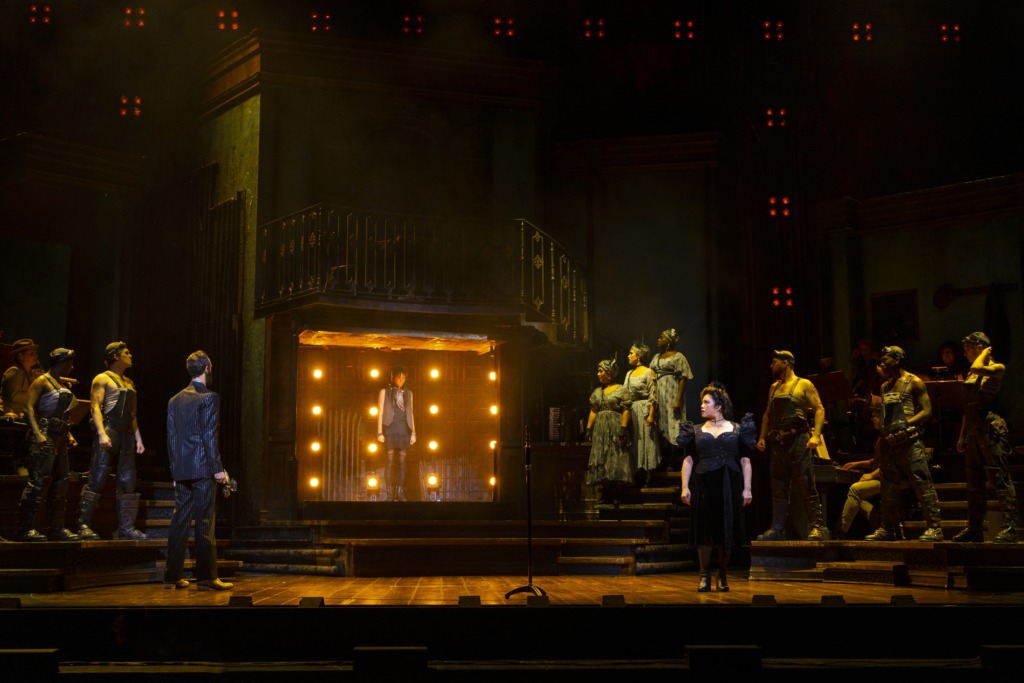
At first glance, much like with Hauck’s set, Michael Krass’ costume design doesn’t appear to be anything special; in fact it all looks rather drab until you start looking closer. Devil’s in the details as they say. Hermes, messenger to/of the Gods? Simple gray suit. Except it catches the light in a way that makes him shimmer like a celestial being. Hades, lord of the underworld. Pinstripes, mafia-leather, shades, and a red-backed vest that— okay, Krass wins straight out the gate with Hades because that costume is badass, wicked, and wonderful from jump-street. And Persephone too, with her fierce, blindingly-bright chartreuse affair that looks like spring is trying to jump out of her skin via the fabric of that dress. The drab gray and monochrome set of gowns on the fates at first seem uninspiring but as they swish and sway around the stage you catch glimpses of patterns in the fabric, you note little glittery bits or shiny black beadwork that gives you an appreciation for what it is they represent. And the ensemble— the hardest working dance-sing-corps of five— have the street clothes of the oppressed and showcase that calamitous couture once they become absorbed into the masses of the undead in the underworld. Krass’ work is designed to make you think, allow you to see beyond what you’re seeing, and it’s astonishing for the effect that it adds to the show.
Hadestown features more than just dancing. Choreographer David Neumann has infused choreographed movement into the non-dance moments in this production as well. (The use of a modest turntable in Rachel Hauck’s set only adds to the imagery that such movements create throughout the performance.) There is a lot of feel-good movement; there is a lot of body-jerking movement. And there is a lot of precision-based, gesticulation of arms, legs, and bodies that really amp up the musical experience. A great amount of the show’s dance work falls on the talented shoulders of The Worker Chorus (Jordan Bollwerk, Jamal Lee Harris, Courtney Lauster, Eddie Noel Rodríguez, Raquel Williams.) This quintet of triples-threats have motion and music well in hand. They spin furniture and their bodies during “Wedding Song” to create the illusions of nature setting up for a wedding; they stomp and gesture and decry proudly in harmony during “Why We Build the Wall” and they shake off the illusion of being mindless worker drones finally seeing the light during “If It’s True.” Bollwerk, Harris, Lauster, Rodríguez, and Williams become a tidal current, pushing and pulling, ebbing and flowing with the narrative of this production, with the music of this show, with the soul and spirit of this performance.
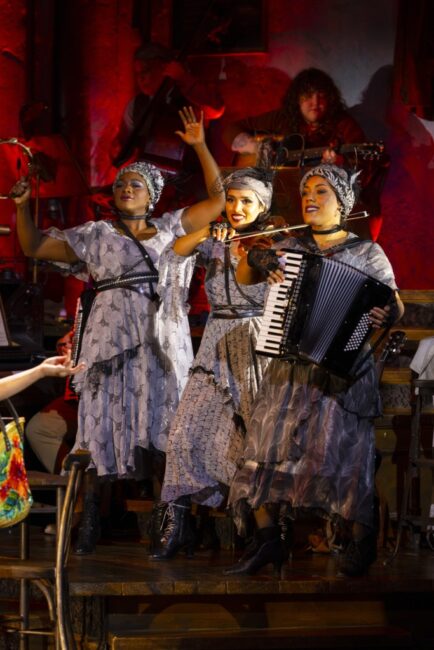
Like building the perfect recipe, herein you add a pinch of sass, humor, class, and foreboding. Enter The Fates— Dominique Kempf, Belén Moyano, Nyla Watson. This trio of voices is both dazzling and eerie, delightful and disturbing, whispering as if they are the wind, shouting as if they are the storm. And their movements are unearthly, making one believe that they truly might be otherworldly fates. In their acapella feature “Word to the Wise” you hear the strength of each individual voice of Kempf, Moyano, and Watson, as well as the unified trio of their blended harmonies and unsettling melodies as they sing at Hades about what will happen if and when he makes a choice. As the story says, you can hear them knocking about in the back of your mind and these three extraordinarily talented women are constantly burbling about in the background, drifting forward every so often both in song and presence to remind you that fate is always a part of your journey, and often it is out of your control.
The one truly remarkable component about Hadestown— a derivative effort of the entire company and crew— is its ability to surprise. In Titanic, the ship sinks. In 1776, they sign the declaration. Known facts. Immutable truths that aren’t spoilers but can, at time, feel like foregone conclusions. Never once when you enter the experience that is Hadestown do you find yourself feeling like you know the ending. These are master weavers of story, of heart, of feeling— so much so that even those of us that know the story well (and a bit like that book “They Both Die at the End” by Adam Silvera, Hermes even tells you right from the opening lines exactly what the story is)— are gutted when that moment happens. It is an extraordinary rendering of the vicious but beautiful cycle of life, the way the seasons blossom, thrive, and die. Only to be reborn again. With hope anew that this time it will last. You’re wholly engaged with this journey every step of the way, never once thinking about the ending until you’re broadsided by it.
There are five principals who take up the mantle of storyteller. Though in Hadestown, it is so much more than narrative responsibility laid upon this quintet of musical magicians who sing, dance, emote, feel, narrate, and explore the world around them while simultaneously relating that experience to us. Orpheus (J. Antonio Rodriguez) and Eurydice (Hannah Whitley) have their story told while living it blindly. Hermes (Nathan Lee Graham) is but the messenger of this tale. Hades (Matthew Patrick Quinn) and Persephone (Lana Gordon) protagonistic antagonists or antagonistic protagonists, as it is as much their story as anyone else’s. The five come together in an extraordinary way; their voices sharing the responsibility for the show’s overarching pathos, the mystical lyrics and haunting tunes that will linger with you long after you leave the theatre for the night.
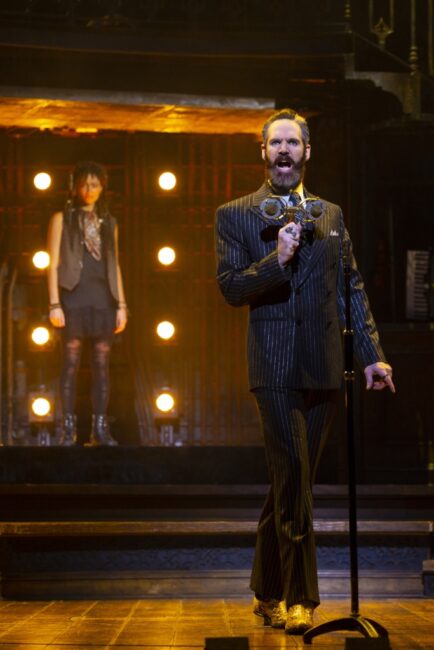
With a booming deep basement-of-basement-bass tones, Matthew Patrick Quinn is a slick, sleek, charismatic force to be reckoned with. Ironically enough, you don’t even get to hear him sing straight away; it’s just the imposing figure he cuts— smartly dressed in that dapper suit and carefully crafted ‘underground mafia’ look— and the way he slides into a scene as if he is night and shadow incarnate. His first number, “Hey, Little Songbird,” is enough to shake your spine straight out of your skin. It’s both sinful and soulful; a whole host of confusing emotions— unsavory and yet sensual, oozing and yet soothing. Quinn embodies Hades with fervor, making him that character you can delight in watching as he encounters others but perhaps one you would wish to avoid encountering personally. There’s a deep complexity that Quinn brings to Hades as well, the precariously balanced fury and ire, tempered with seductive rage, possessive power, and searing jealously, all of which emanates from the core of his being, sweeping up through his hypnotic, deep voice during numbers like “Why We Build the Wall” or that harrowing duet performed with Persephone, “How Long?”
Persephone (Lana Gordon) is a law unto her own. Packing more punch and spirit than a whole host of spring flowers, summer showers, and a heatwave combined, Gordon delivers a split persona when it comes to this Queen of the Underworld. There’s sassy, silly, party-power-forward fun from Gordon when she arrives on the scene in “Livin’ It Up On Top” with a wild, carefree dance break that makes her look almost as if she’s possessed. And when she back-bends over herself, with her head practically touching the ground to belt out an unbelievably powerful note at the end of “Our Lady of the Underground”, it defies description in an astonishing and amazing fashion. Some of her balance-based movements, particularly the isometric pelvic pulses and strut-sweep movements that make her look as if she might just pitch over completely are remarkable. You get the serious, grounded (or under-grounded?) side of Persephone from Gordon later in the second act, particularly when she squares off with Hades for “How Long?”, which is a true showcase of both of their vocal capabilities as well as her narrative and singing prowess.
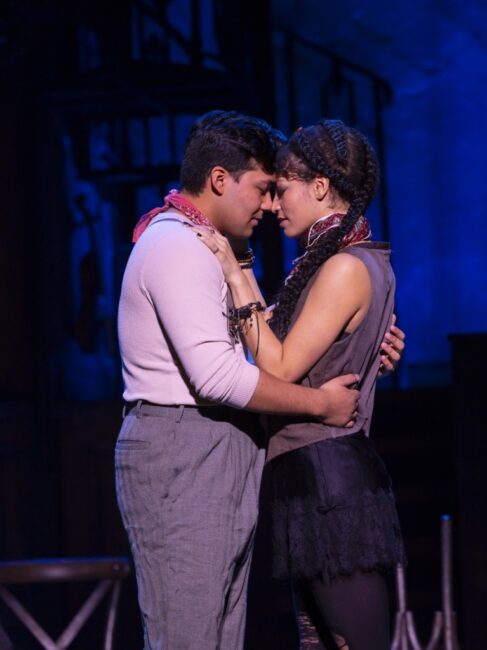
Lovers. Sweethearts. Two-people-in-a-meet-cute-moment-in-a-musical. If that doesn’t spell doomed from the start, I don’t know what does. But Orpheus (J. Antonio Rodriguez) and Eurydice (Hannah Whitley) are so much more than what their fates predicate them to be. Rodriguez has the voice of an unholy angel, perhaps not even of this world. It’s a countertenor sound that pierces the soul and just sends you— to Olympus in serene bliss and jubilation; to Hades in woe-weighted sorrow and despair. You can see how the song of Orpheus might bring about spring or melt the heart of Hades when being sung by Rodriguez. But Rodriguez possesses more than just a stellar countertenor range. His emotional depth rivals something akin to the pits of Tartarus when it comes to traversing the ranges of pathos his character experiences on this epic odyssey. The fury that seethes through “If It’s True”, the doubt that plagues “Doubt Comes In”, the adoration that lilts along his vocal track every time he sings to or about Eurydice; it’s astonishing. His soul-searing, torch song, “Wait For Me” is an inferno of feeling that just blazes across the house and straight into your soul.
Whitley, as the ‘hungry girl’, has as vast and complex a vocal range and emotional depth as Rodriguez’ Orpheus, making them a perfect match. Her voice is haunting but serene, chilling but fire; it’s a wild paradox of impossibilities that tear through these moments in song like the storm that threatens their existence. “Gone, I’m Gone” is one of the more bewilderingly beautiful and tragically pretty songs that Whitley delivers in this production, and you feel her maelstrom of unnamable emotions that she’s channeling into that number. “Flowers” is equally harrowing and haunting, delivering those heartbreaking sentiments of remorse and regret through her tranquil voice with tarnished pathos in tow. She delivers jarring imagery; dissonant beauty with struggles beyond compare, all neatly packaged by her impressive voice. When she’s in duet with Rodriguez’ Orpheus, their voices twine together like a love that transcends time and space. It’s quite the accomplishment.
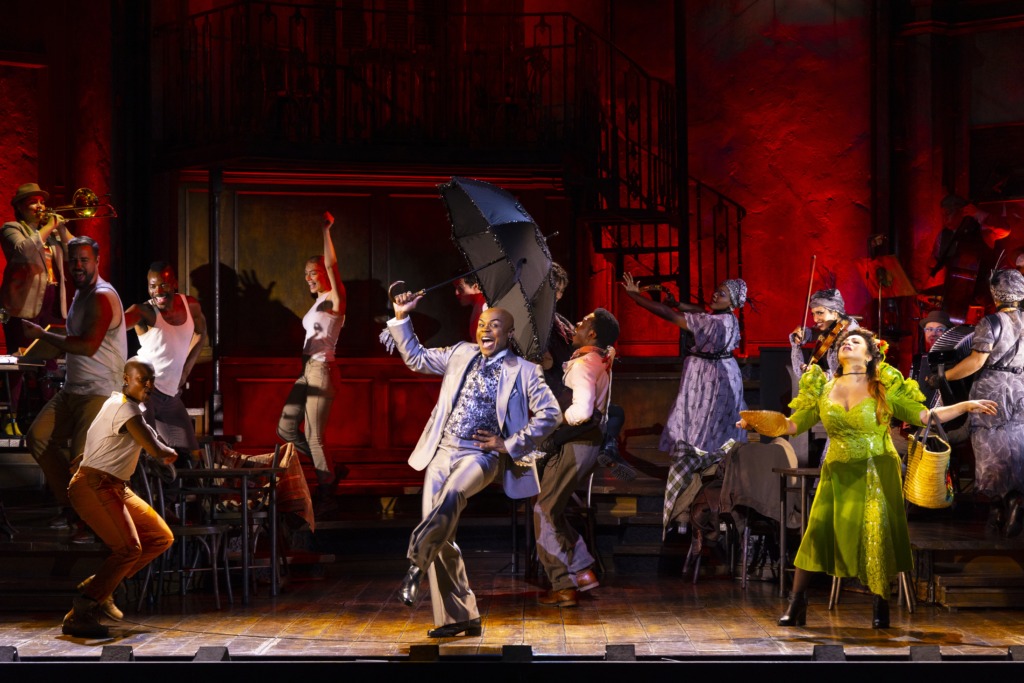
Master of ceremonies, ringmaster of the narrative circus, all-round showman who is both in the story, telling the story, and above the story, Nathan Lee Graham as Hermes is an all-encompassing representation of Hadestown. He is fate, he love, he is tragedy— he is song, he is dance, he is spirit. Graham never falters; not in his enthusiasm or his disturbing moments of severe intensity. And he balances both to perfection, like a true spirit of the Gods… a messenger if you will. The repetition, though subtle and ever-shifting, is strong with his character and yet you never feel as if you’re hearing a record stuck on repeat when it comes to Hermes. When Graham welcomes the house, gets the joint jumping so to speak, you can sense a powerful experience is about to commence. “Road to Hell” the opener, in Graham’s capable hands is undeniably engaging and all-round enthusiastic; a perfect way to start a show. “Road to Hell (Reprise)” is stark, bleak, tragically beautiful and completely the opposite of the way he started the show and yet the words are almost identical. It’s mind-blowing to see Graham deliver both in such striking opposition to the other. Graham’s vocal affectations bring a level of playfulness to the character and the experience as a whole; you never know just what might come out of his mouth, but whatever and whenever and wherever it is— it is spirited.
It’s an old song. It’s a sad song. It’s a love song. And you’d be a fool to miss it. Hadestown will shake you to the core; it will open your eyes— and let you see the world as it can be, in spite of how it is. Do not miss this golden opportunity to theatrical brilliance while it’s here in Baltimore.
Running Time: Approximately 2 hours and 35 minutes with one intermission
Hadestown plays through April 16th 2023 at The Hippodrome Theatre in The France-Merrick Performing Arts Center- 12 North Eutaw Street Baltimore, MD 21201. For tickets call (410) 837-7400 or purchase them online.
